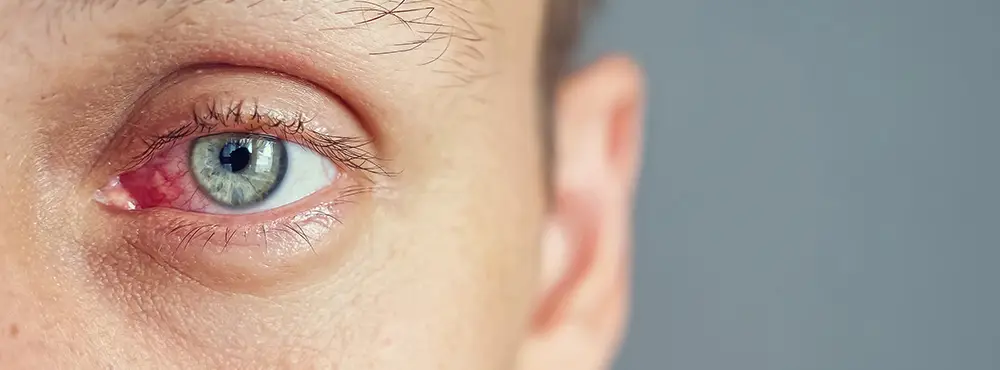This article looks at bacterial keratitis, its causes, diagnosis, symptoms, and treatment.
What is bacterial keratitis?
Bacterial Keratitis is a bacterial infection of the cornea (the clear dome which covers the coloured part of the eye). This corneal infection can affect both contact lens wearers and those who do not wear contact lenses.
There are two common types of bacteria associated with bacterial keratitis, these are:
- Pseudomonas aeruginosa - found in soil and water
- Staphylococcus aureus - this type of bacteria usually lives on the skin of the human body or on the mucous membrane (e.g. the lining of the nose, eyes or mouth)
Pseudomonas aeruginosa is a common cause of bacterial keratitis in contact lens wearers, and is often related to overuse of contact lenses, poor hygiene, for example using tap water or saliva to ‘clean’ lenses.
Bacterial keratitis signs and symptoms
Signs and symptoms of bacterial keratitis are varied and include:
- Eye pain, particularly in bright light
- Eye redness
- Eye discharge
- Blurry vision
- Excessive tearing
If you experience any of these symptoms above, remove your contact lenses right away and contact your doctor immediately. Urgent treatment is required to prevent vision loss and if left untreated, bacterial keratitis can lead to blindness.
Bacterial keratitis causes
The two main causes of bacterial keratitis are contact lens wear and eye injury. However there are a variety of risk factors for bacterial keratitis, including:
- Eye disease
- Eyelid problems or tearing
- Weakened immune system
Risk factors for bacterial keratitis with contact lenses include:
- Extended wear
- Orthokeratology (Ortho-K) - wearing RGP lenses overnight to correct myopia by temporarily reshaping the cornea
- Failing to clean and disinfect contact lenses correctly
- Not cleaning contact lens case
- Contact with water
- Using contaminated contact lens solution
- Topping off old contact lens solution with new solution
- Sharing contact lenses
Preventing bacterial keratitis
One way to help prevent bacterial keratitis is by taking proper care of your contact lenses, ensuring that you clean and disinfect your lenses thoroughly. Daily wear contact lenses are a great idea if you struggle to keep up with your cleaning regime. When wearing contact lenses make sure to follow these tips:
- Remove your lenses before going to sleep
- Wash your hands thoroughly with a mild soap and dry them with a lint-free towel before handling your contact lenses
- Make sure you use the correct lens care products recommended to you by your optician
- Follow the suggested replacement schedule of your contact lenses
- Replace your contact lens case with a new one every three months
- Never wear contact lenses when swimming or showering
- Discard any old solution in your lens case before disinfecting your lenses
- Handle your lenses with care as rough handling can cause them to get scratched or damaged
How is bacterial keratitis diagnosed?
Bacterial keratitis can be diagnosed with a complete ophthalmologic exam and a detailed history taken by a physician.
History
Before a physical examination, a physician will look at the history of your symptoms and their characteristics.
They may ask you whether you experienced a recent eye injury or whether you have engaged in certain activities, for example, swimming while wearing contact lenses. If you wear contact lenses, they may also ask you about the type of lenses you wear, when you last changed them, if you use your contact lenses for extended wear and your cleaning regime.
Your physician will also ask if you have a history of eye trauma, eye diseases or surgery. They will look into your medical history to find out what medications you take, whether you have allergies and if you have a history of substance abuse.
Physical examination
During the physical examination, your ophthalmologist may take corneal scrapings and send it to a laboratory to see if any particular microbes are present under a microscope (or grow on nutrient jelly). They will also look at your vision, intraocular pressure, pupils, and will use a slit-lamp to look at your eyes and determine whether there is corneal infiltrate or inflammation affecting the inside of the eye as well.
Bacterial keratitis treatment
Bacterial keratitis is treated with intensive topical antibiotic eye drops, typically different to those used to treat bacterial conjunctivitis. These are not available over the counter and require prescription. You may need to see your ophthalmologist on more than one occasion for treatment. It is imperative to seek treatment early in order to prevent sight loss or total blindness.
Disclaimer: The advice in this article is for informational purposes only and does not replace medical care or an in-person check-up. Please check with an eyecare professional before purchasing any products or remedies. For information on our article review process, please refer to our Editorial Policy.

 Offers
Offers Account
Account
 Favorite
Favorite
 Basket
Basket

 OFFERS
OFFERS















